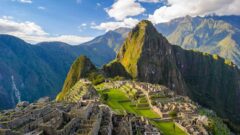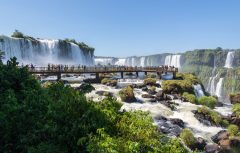Surreal Architecture

Continuing our surreal theme, a countdown to prove man can compete with Mother Nature when it comes to the absurd.
The Brazilian capital boasts too many architectural oddities to choose just one. A modernist masterpiece, the city was constructed from scratch in the late 1950s as a purpose-built capital, replacing Rio on the overcrowded southern coast. As well as being a rather audacious attempt at population redistribution, the city was also conceptualised as the embodiment of the country’s motto: ‘order and progress’. This ethos is reflected in its many sparely designed, architecturally daring public buildings, most of which were the work of Oscar Niemeyer. As a measure of Brasilía’s success, it now has a population close to three million, and has been recognised as a UNESCO world heritage site in record time – just 27 years after its inauguration.
Edward James was a British poet and impassioned patron of the surrealist movement, whose search for ‘Eden’ led him to create one of Mexico’s strangest and most beguiling attractions. His sculpture gardens (known as ‘Las Pozas’) near the village of Xilitla are a haven of natural pools and waterfalls, interlaced with surrealist monuments, follies and sculptures. That few have heard of it just enhances the experience of visiting. Our tour leader Peter Noyce highly recommends it: “Imagine stepping in to a Dali painting where concrete juxtaposes the relentless wild growth of the rainforest – welcome to the world of Edward James.”
Created by Brazil’s most celebrated architect, Oscar Niemeyer, the auditorium in São Paulo’s Ibirapuera park forms part of a suite of buildings demonstrating Brazil’s love of modernist architecture. With a distinctive entrance-way that juts, like the door of a spaceship, into the air, it is surely amongst their most bizarre.
This shell-inspired house in Mexico City is by no means the only surreal creation by Javier Senosiain – the Mexican architect has created buildings in the shape of snakes, sharks, whales, flowers and more – but it is, perhaps, his oddest. The building is just as impressive from the inside as the outside: the coloured glass mosaic makes an astonishing backdrop for an indoor garden. To see more of Senosiain’s work, visit arquitecturaorganica.com
A relatively short journey away from Bogotá lies Zipaquirá, a town known for its salt mines. Over many years, pious miners carved an enormous underground church within the solemn stone tunnels of one of these mines, which has now been artfully embellished with sculpture and light. The unique structure is complete with 14 chapels representing each of the stations of the cross, and a labyrinth of solid stone passages that connects the atmospheric chambers.
Tailor-made holidays
Flexible, custom-made holidays to Latin America created to match your exact requirements: our tailor-made itineraries are as unique as the clients for whom they are designed.
Design my tripPapagaio
Your edit for Latin American inspiration
Our exciting range of articles on Latin America explore everything from iconic destinations and lesser-known cultural gems to delicious traditional recipes. You’ll also find exclusive travel tips, first-hand client reviews and the chance to get your personal questions answered by our travel experts.
View Extraordinary Inspiration






































